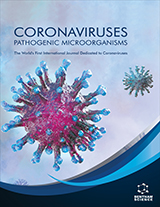Abstract
Since the start of the decade, the coronavirus disease 2019 [COVID-19] pandemic has disrupted the world's healthcare system. Scientists have been engaged to bring about a therapeutic agent to help combat the dreaded disease. Many researchers have shown antivirals such as Remdesivir and Favipiravir to be effective in the treatment; however, these drugs have a short half-life. Hence, the need for a drug delivery system that could prolong or alter their effect by increasing the potency of antivirals or vaccines has been proposed. Nanotechnology has always been at the forefront of developing and diagnosing diseases. The idea of which can be borrowed to treat the novel coronavirus. The applicability needs to be vast as the disease has spread, and a fast, reliable, effective therapeutic and diagnostic procedure is the need of the hour. Emphasis on nanotechnology usage through the intranasal and pulmonary route has been given and various applications have also been discussed in this review.
Keywords: COVID-19, diagnosis, nanotechnology, antiviral, vaccine, coronavirus.
Graphical Abstract
Coronaviruses
Title:Nanotechnology Advancements in the Diagnosis and Prevention of COVID-19: Past and Future
Volume: 2 Issue: 11
Author(s): Leander Corrie*, Raghunandan Gundaram and Latha Kukatil
Affiliation:
- School of Pharmaceutical Sciences, Lovely Professional University, Phagwara, Punjab144411,India
Keywords: COVID-19, diagnosis, nanotechnology, antiviral, vaccine, coronavirus.
Abstract: Since the start of the decade, the coronavirus disease 2019 [COVID-19] pandemic has disrupted the world's healthcare system. Scientists have been engaged to bring about a therapeutic agent to help combat the dreaded disease. Many researchers have shown antivirals such as Remdesivir and Favipiravir to be effective in the treatment; however, these drugs have a short half-life. Hence, the need for a drug delivery system that could prolong or alter their effect by increasing the potency of antivirals or vaccines has been proposed. Nanotechnology has always been at the forefront of developing and diagnosing diseases. The idea of which can be borrowed to treat the novel coronavirus. The applicability needs to be vast as the disease has spread, and a fast, reliable, effective therapeutic and diagnostic procedure is the need of the hour. Emphasis on nanotechnology usage through the intranasal and pulmonary route has been given and various applications have also been discussed in this review.
Export Options
About this article
Cite this article as:
Corrie Leander *, Gundaram Raghunandan and Kukatil Latha, Nanotechnology Advancements in the Diagnosis and Prevention of COVID-19: Past and Future, Coronaviruses 2021; 2 (11) : e130921190596 . https://dx.doi.org/10.2174/2666796702666210122123141
| DOI https://dx.doi.org/10.2174/2666796702666210122123141 |
Print ISSN 2666-7967 |
| Publisher Name Bentham Science Publisher |
Online ISSN 2666-7975 |
 12
12
- Author Guidelines
- Graphical Abstracts
- Fabricating and Stating False Information
- Research Misconduct
- Post Publication Discussions and Corrections
- Publishing Ethics and Rectitude
- Increase Visibility of Your Article
- Archiving Policies
- Peer Review Workflow
- Order Your Article Before Print
- Promote Your Article
- Manuscript Transfer Facility
- Editorial Policies
- Allegations from Whistleblowers
- Announcements
Related Articles
-
Clinical Significance of Pleiotropic Effects of Statins: Lipid Reduction and Beyond
Current Medicinal Chemistry Imaging Reporters and Multimodal Molecular Bio-Imaging: A Database of Available Probes for Multi-Modality Bio-Imaging of Reporter Gene Expression
Recent Patents on Medical Imaging Changes of Expression of the Protein C Pathway Components in LPSInduced Endotoxemia–Implication for Sepsis
Cardiovascular & Hematological Disorders-Drug Targets Functional Roles of Benzothiazole Motif in Antiepileptic Drug Research
Mini-Reviews in Medicinal Chemistry Reactive Oxygen Species, Cancer and Anti-Cancer Therapies
Current Chemical Biology Drug Tissue Distribution: Study Methods and Therapeutic Implications
Current Pharmaceutical Design The Mechanism of Carvedilol in Experimental Viral Myocarditis
Current Pharmaceutical Design Neuroinflammation: A Therapeutic Target of Cotinine for the Treatment of Psychiatric Disorders?
Current Pharmaceutical Design New Strategies for Managing Anemia of Chronic Kidney Disease
Cardiovascular & Hematological Agents in Medicinal Chemistry Recent Patents in Pulmonary Delivery of Macromolecules
Recent Patents on Drug Delivery & Formulation The Endothelial-Mesenchymal Transition (EndMT) and Tissue Regeneration
Current Stem Cell Research & Therapy Hot Melt Extrusion and its Application in 3D Printing of Pharmaceuticals
Current Drug Delivery The Effect of TNFα-Inhibitors on Cardiovascular Events in Patients with Rheumatoid Arthritis: An Updated Systematic Review of the Literature
Current Rheumatology Reviews Hypersensitivity Reactions to Anticoagulant Drugs
Current Pharmaceutical Design Brutons Tyrosine Kinase as a New Therapeutic Target
Anti-Cancer Agents in Medicinal Chemistry Primary and Secondary Hypertriglyceridaemia
Current Drug Targets Translational Multimodality Neuroimaging
Current Drug Targets Markers of Systemic Inflammation in Obstructive Sleep Apnea Syndrome
Current Respiratory Medicine Reviews Current Hydrogel Solutions for Repairing and Regeneration of Complex Tissues
Current Medicinal Chemistry Cytokine and Nitric Oxide Production Following Severe Envenomation
Current Drug Targets - Inflammation & Allergy



























